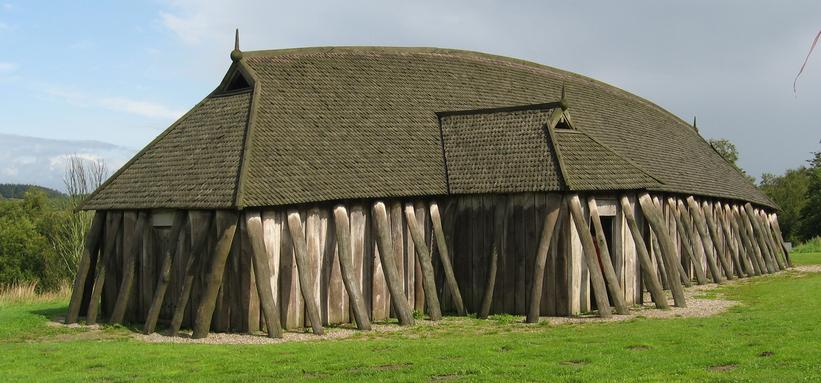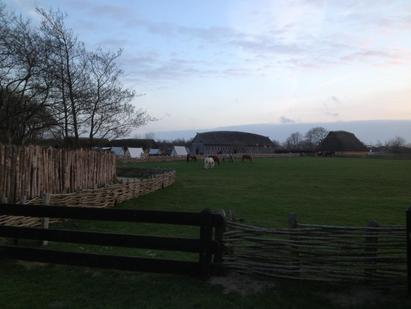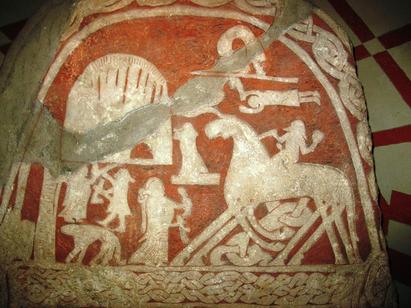What were Viking homes like?

Viking homes have been found in nearly all parts of Denmark. Only a small proportion of the Vikings lived in towns. Most of them were farmers, who lived in small villages consisting of 6-7 farms. For them the farm, domestic animals and agriculture were all pivotal to the daily routine. The day started when the cock crowed at dawn.
The farm
Most Vikings lived on a farm, which was often bounded by a fence. The farm was centred around a dwelling house – the longhouse – which was the main building. Apart from the dwelling house, the farm often consisted of various areas of activity and other buildings, including outbuildings, barns, stables and workshops.
In villages the farms were normally grouped around an open area or common street.
The longhouse on the farm

Viking houses were built of wood. The longhouses had bowed walls in plan, forming a ship-like outline. The walls were lined with clay or consisted of wooden planks placed vertically into the ground, which supported the roof, along with two rows of internal posts. Outside the house was often supported by sloping posts. Roofs were slanted and could be thatched or wooden.
In the middle of the house was an oblong fireplace – the long fireplace. Here the food was made. Along the walls there were plank beds, on which the Vikings could sit or sleep. At one end of the house the animals were housed in stalls, if there were no stables at the farm.
The Vikings constantly repaired their houses. Damp was the great enemy as it led to rotting. However, they also knew how to protect the wood by scorching the posts of their houses.
Smoky houses
Viking houses did not have chimneys or windows. Instead, there was a hole in the roof, where the smoke from the fire escaped. The lack of ventilation meant that there was a great deal of smoke in a Viking house. This is comparable to houses with open fireplaces, which are still found today in parts of Africa and India. Women and young children, in particular, who live in such houses are affected by lung diseases and the smoke level is well above the World Health Organization’s recommendations.
Banquets

Hospitality and banquets played an important role in the Viking period. Hospitality was available for travelling strangers, who could go into the nearest farm and seek food and lodging. In addition, banquets were held, to which friends and neighbours were invited for celebrations connected with the festivals of the year, weddings and funerals.
Banqueting plays an important role in the Viking societies described in the saga literature and eddic poems. These include advice and rules about how one should behave as a guest, and not least how a host should behave towards a guest.
A well-known reception scene is depicted on a Gotlandic picture stone. A door is shown. In front of the door stands a woman with a drinking horn in her hand, ready to receive guests. The scene is often interpreted as the arrival of dead warriors at Valhalla, and the woman as a valkyrie, who is receiving them. However, the scene may also show how the reception to an ordinary banquet was performed.
Buried close to the settlement
The Vikings buried their dead a short distance from the settlement, typically 300 - 600 m away. Many farms and burial places were separated by a watercourse. This has been identified at significant Danish sites, such as Gammel Lejre and Tissø on Zealand and Mammen, near Viborg, in Jutland.
The explanation for this may be found in Norse mythology, in which the watercourse Gjöll divided the land of the living from that of the dead. Comparisons can be drawn with Greek mythology’s river Styx, upon which the ferryman Charon received payment to ensure transport to the land of the dead known as Hades.
Perhaps such locations for burial sites can be seen as evidence of the Viking religion? However, such an interpretation is not appropriate for all Viking burial places. A significant number of burial sites are located more than 1 km from a watercourse. Here other explanations are likely to be involved.
